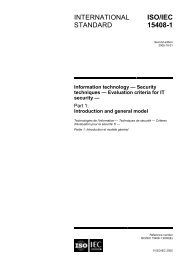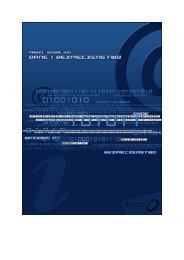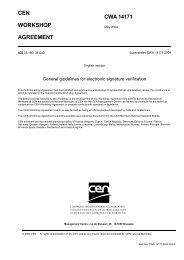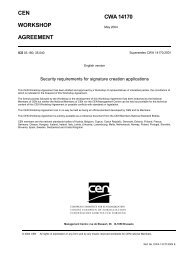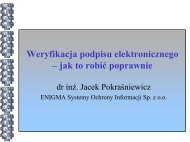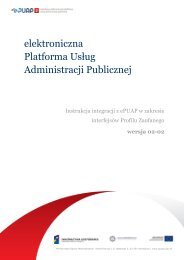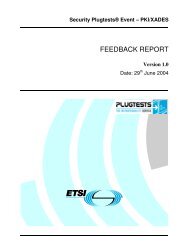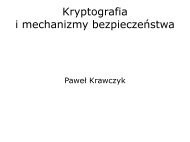Electronic identification, authentication and signatures 1 ... - IPSec
Electronic identification, authentication and signatures 1 ... - IPSec
Electronic identification, authentication and signatures 1 ... - IPSec
Create successful ePaper yourself
Turn your PDF publications into a flip-book with our unique Google optimized e-Paper software.
22/02/2011 ec.europa.eu/yourvoice/ipm/forms/disp…<br />
<strong>Electronic</strong> <strong>identification</strong>, <strong>authentication</strong> <strong>and</strong> <strong>signatures</strong><br />
1. Respondent information<br />
Are you replying:<br />
As an individual citizen<br />
Please provide your Name <strong>and</strong> Surname<br />
Paweł Krawczyk<br />
Please provide your email address<br />
pawel.krawczyk@hush.com<br />
Your country of residence<br />
Pol<strong>and</strong><br />
2. General expectations regarding EU<br />
legislation on e-<strong>signatures</strong>, e-<strong>identification</strong> <strong>and</strong> e-<br />
<strong>authentication</strong><br />
Question 1: Do you / Does your organisation use e-<br />
<strong>signatures</strong>, e-<strong>identification</strong> <strong>and</strong> e-<strong>authentication</strong>?<br />
no<br />
If no, why?<br />
Question 2: For what online transactions do you<br />
consider electronic <strong>identification</strong>, <strong>authentication</strong><br />
<strong>and</strong> <strong>signatures</strong> useful in coming years?<br />
No need<br />
Too complex<br />
Too expensive<br />
eGovernment services<br />
<strong>Electronic</strong> Public Procurement<br />
eCommerce transactions<br />
eBusiness transactions<br />
Online banking <strong>and</strong> financial transactions<br />
Issuance of authentic electronic documents<br />
Secure archiving or storage of authentic electronic<br />
documents<br />
Question 3: What socio-economic benefits or drawbacks do you expect from the use of electronic<br />
<strong>signatures</strong>, <strong>identification</strong>, <strong>and</strong> <strong>authentication</strong> in other sectors of activity than yours?<br />
<strong>Electronic</strong> signature must be market driven, not government driven. In Pol<strong>and</strong> electronic certificates were<br />
owned by less than 0,1% of population between 2001 <strong>and</strong> 2008. Then government forced 200'000 enterpreneurs<br />
to use qualified certificates that resulted in spending 60-100 million PLN on first year <strong>and</strong> then 40 million PLN<br />
annually - without any benefit for either companies or government. Usage is now still under 1%.<br />
Question 4: Would a stronger involvement of<br />
financial institutions in the provision of trusted e-<br />
signature <strong>and</strong> e-<strong>identification</strong> services have an<br />
impact on the take-up of e-signature <strong>and</strong> e-<br />
yes<br />
ec.europa.eu/yourvoice/ipm/…/dispatch 1/6
22/02/2011 ec.europa.eu/yourvoice/ipm/forms/disp…<br />
<strong>identification</strong> in other sectors?<br />
If yes, what would be the appropriate incentives?<br />
Banks already have quite well verified personal information in their databases, so they could be offering<br />
identity provider services (in IDA BC Authentication Policy meaning). At the same time they could be also<br />
identity services consumer. But all this needs to be well designed <strong>and</strong> make economic sense. This<br />
already works in private sector - for example on some auction sites you can authenticate yourself by<br />
making a $0,01 transfer from your bank account.<br />
Question 5: Do you think that there are specific<br />
interoperability or security aspects that should be<br />
taken into account to foster the use of electronic<br />
<strong>signatures</strong>, <strong>identification</strong> <strong>and</strong> <strong>authentication</strong><br />
through mobile devices (e.g. requirements on the<br />
SIM cards, on the h<strong>and</strong>set, on the mobile operator)?<br />
If yes, regarding:<br />
yes<br />
operational<br />
technical<br />
st<strong>and</strong>ardisation<br />
other<br />
Please comment why<br />
Business - much of the legislation done so far in EU around electronic signature didn't make any<br />
economic sense. It was not designed to solve any concrete problems <strong>and</strong> as result it was designed to be<br />
so general that it became unusable. Technical - end-user facing technology behind electronic signature<br />
is not mature enough. It's ridiculous to ask a consumer to install numerous drivers <strong>and</strong> certificates in<br />
their operating system <strong>and</strong> tell them this is more secure than plain SSL. St<strong>and</strong>ardisation - there's 27<br />
electronic signature laws in EU <strong>and</strong> they're mostly incompatible. In Pol<strong>and</strong> alone there's 14 electronic<br />
signature formats, <strong>and</strong> they're incompatible too.<br />
Question 6: For which of the following trust building<br />
services <strong>and</strong> credentials should legal or regulatory<br />
measures be considered at EU-level in order to<br />
ensure their cross-border use <strong>and</strong> why?<br />
Certified electronic documents in general<br />
3. e-<strong>signatures</strong> tailored to face the challenges<br />
of the digital single market<br />
Question 7: How do you judge the take-up of<br />
electronic <strong>signatures</strong> in Europe?<br />
Marginal<br />
Please comment why<br />
In countries where electronic signature was promoted by government it was actually only taken up by<br />
government itself or where people were forced to use it (Polish ZUS system). Otherwise usage of QES is<br />
marginal <strong>and</strong> many countries (e.g. UK, Denmark) were able to build successful <strong>and</strong> widely available e-<br />
government portals without QES. Another clue comes from Estonia, where 90% population has QES<br />
certificates issued as part of their e-ID documents, but due to technical difficulties actually only 5% is<br />
using it.<br />
ec.europa.eu/yourvoice/ipm/…/dispatch 2/6
22/02/2011 ec.europa.eu/yourvoice/ipm/forms/disp…<br />
Question 8: Which of the following issues have a<br />
negative impact on the uptake of e-signature? You<br />
may select up to three answers that have according<br />
to you the most important impact.<br />
Costs of using e-<strong>signatures</strong><br />
Lack of user-friendly signature solutions<br />
Transactions can sufficiently be secured with other<br />
means<br />
Question 9: Which of the following specific issues<br />
have an impact on cross-border interoperability of<br />
e-<strong>signatures</strong> in Europe <strong>and</strong> should be addressed in a<br />
revised legal framework on e-signature (the<br />
references point to the articles <strong>and</strong> annexes of the<br />
eSignatures Directive)?<br />
Unclear terminology in Directive 1999/93/EC <strong>and</strong><br />
heterogeneous terminology in national legislations<br />
Divergent interpretations of what is meant by the "sole<br />
control" of the signatory (art. 2.2)<br />
Heterogeneous approach to security requirements<br />
(e.g. certification requirements on the signing<br />
software in some countries)<br />
No EU list of signature equipment formally recognised<br />
as "secure signature creation devices" (Directive Annex<br />
III)<br />
Other<br />
Please comment why<br />
The first question that you should ask yourself <strong>and</strong> EU citizens when desigining new <strong>authentication</strong><br />
framework is: what is it going to be used for? Another solution that is designed "for everything" will be<br />
effectively useful for nothing.<br />
Question 10: Which among the following options<br />
could be solutions for signature verification <strong>and</strong><br />
validation at EU level?<br />
European central validation service<br />
Question 11: Do you have specific expectations<br />
from e-signature st<strong>and</strong>ardisation to cover?<br />
Question 12: Do you use "qualified" e-<strong>signatures</strong>?<br />
No expectations<br />
yes<br />
If yes, how often per month <strong>and</strong> for which kind <strong>and</strong> value of transactions?<br />
Once per two months <strong>and</strong> I usually use it to submit consultation documents to government bodies as<br />
part of public consultation (no value).<br />
Question 13: What is your view on the need to<br />
revise the security provisions of "qualified" e-<br />
<strong>signatures</strong>?<br />
Security requirements should be relaxed<br />
Question 14: Would a classification of a range of e-<br />
<strong>signatures</strong> be desirable to match different levels of<br />
security?<br />
Yes, a classification would be convenient, it should be<br />
defined by law <strong>and</strong> a legal effect should be associated<br />
to each or some classes.<br />
Please comment <strong>and</strong> explain for which usage a classification would be desirable.<br />
There's a lot of business <strong>and</strong> administrative processes in the world with VERY different risk profiles <strong>and</strong><br />
security requirements. Creating a single <strong>authentication</strong> mechanism to cover them all would require that<br />
it satisfies security requirements of the highest level. Enforcing it would effectively kill all other<br />
processes with smaller security requirements, <strong>and</strong> usually they're majority of these processes. For<br />
example, would you consider QES a reasonable means of <strong>authentication</strong> to request a record from<br />
otherwise public register of companies? In Pol<strong>and</strong> it's required <strong>and</strong> obviously everyone is still requesting<br />
this on paper.<br />
ec.europa.eu/yourvoice/ipm/…/dispatch 3/6
22/02/2011 ec.europa.eu/yourvoice/ipm/forms/disp…<br />
Question 15: Should "electronic consent" be<br />
recognised formally by future European legislation?<br />
no<br />
Question 16: Should "electronic consent" be<br />
considered as equivalent to electronic <strong>signatures</strong>?<br />
Question 17: Are there specific aspects that should<br />
be taken into account to address electronic<br />
archiving?<br />
yes<br />
yes<br />
If yes, please specify the legal provisions which are needed in your opinion to address electronic<br />
archiving needs?<br />
Long term electronic signature conservation, cryptographic algorithms.<br />
4. Principles to guide e-<strong>identification</strong> <strong>and</strong> e-<br />
<strong>authentication</strong> in europe<br />
Question 18: Do you see a need for additional legal<br />
or regulatory measures on electronic <strong>identification</strong><br />
at EU-level?<br />
If yes, in your opinion, what are the general<br />
principles that should underlie the legal<br />
provisions on the mutual recognition <strong>and</strong><br />
acceptance of e-<strong>identification</strong> at EU-level?<br />
yes<br />
Transparency<br />
Affordability<br />
Cross-sector permeability<br />
Question 19: What effects for the digital single<br />
market do you expect from legal provisions on an<br />
EU-wide mutual recognition <strong>and</strong> acceptance of eID<br />
issued in the Member States?<br />
Question 20: How could users provided with<br />
electronic <strong>identification</strong> <strong>and</strong> <strong>authentication</strong> means<br />
benefit from their mutual recognition <strong>and</strong><br />
acceptance across Europe <strong>and</strong> in which sectors?<br />
Reduction of administrative burden<br />
Increase of cross-border digital mobility<br />
Reduction of fraud<br />
Increase of user convenience<br />
Simplification of access to online services<br />
Reduction of numerous UID/passwords<br />
Reduced exposure to ID theft<br />
Common legal basis<br />
Question 21: What are the specific aspects that Common specifications for electronic identities<br />
should be taken into account to achieve cross-sector<br />
interoperability of electronic identities?<br />
Question 22: Please indicate experiences <strong>and</strong> lessons learned in the private sector that could be<br />
transferred to the public sector.<br />
<strong>Electronic</strong> signature is a tool <strong>and</strong> not an objective itself. Public sector should be VERY careful to always<br />
perform a final "reality check" to make sure that anyone will actually use the solutions they created.<br />
ec.europa.eu/yourvoice/ipm/…/dispatch 4/6
22/02/2011 ec.europa.eu/yourvoice/ipm/forms/disp…<br />
5. Legislative measures for the challenges<br />
ahead<br />
Question 23: What European Union legislative<br />
measures on e-<strong>signatures</strong>, e-<strong>authentication</strong> of<br />
natural <strong>and</strong> legal person claims as well as e-<br />
<strong>identification</strong> would be appropriate in your opinion<br />
to best meet the challenges of the digital single<br />
market?<br />
Revise the existing legal framework embracing all<br />
requirements relating to e-<strong>signatures</strong>, e-<strong>identification</strong><br />
<strong>and</strong> e-<strong>authentication</strong> <strong>and</strong> related issues<br />
Opt for different measures to allow for distinct focus,<br />
progress <strong>and</strong> speed of adoption<br />
Focus on light <strong>and</strong> limited measures to facilitate faster<br />
decision <strong>and</strong> implementation<br />
6. Research <strong>and</strong> Innovation<br />
Question 24: On what issues should EU R&D <strong>and</strong> st<strong>and</strong>ardisation focus to have all the necessary<br />
technology to improve eID management?<br />
Usability, interoperability <strong>and</strong> economic feasibility.<br />
Question 25: On which technologies should Research & Development focus to improve the usability of e-<br />
<strong>signatures</strong> <strong>and</strong> electronic <strong>identification</strong> for end users <strong>and</strong> to facilitate the deployment for service<br />
providers?<br />
On any technologies that make the usability objective happen when the new legislation is created.<br />
Enumerating any specific technologies at this moment would make it out-of-date immediately.<br />
Question 26: What technologies could contribute to overcoming the lack of trust in electronic<br />
<strong>identification</strong>, <strong>authentication</strong> <strong>and</strong> <strong>signatures</strong> in the European Single Market (ex. addressing the so-called<br />
"what you see is what you sign" issue)?<br />
The WYSIWYS issue is problem mostly for several academic researchers <strong>and</strong> not for millions of people using<br />
Facebook, eBay or PayPal each in Europe. Assurance level must be adjusted to transaction risk <strong>and</strong> definitely<br />
no one is going to buy a house using electronic signature.<br />
7. Others<br />
Question 27: Europe is fully part of the global economy. However, the forthcoming legal framework<br />
cannot cover non EU countries. Are there nevertheless international issues that should be taken into<br />
account?<br />
Europe is not part of the global economy because it's spending too much time theoretising <strong>and</strong> too little time<br />
solving problems. The QES directive was enacted in 1999 <strong>and</strong> since then QES influence on EU's competitiveness<br />
was ZERO. Now in 2011 you are starting public consultations <strong>and</strong> probably by 2015 you will come up with a<br />
great new legal framework called QES2. By 2020 member countries will implement it... but then no one will be<br />
interested in technology from past decade any more.<br />
ec.europa.eu/yourvoice/ipm/…/dispatch 5/6
22/02/2011 ec.europa.eu/yourvoice/ipm/forms/disp…<br />
Question 28: Would you wish to share some best practices examples outside Europe?<br />
In US <strong>and</strong> UK I can send my tax declarations to tax authority over Internet for the last 10-20 years. In Pol<strong>and</strong> I<br />
can do this for 2 years now. In US I can keep a bank transfer printout as proof of transaction for tax reasons,<br />
in EU I need to go through an extremely formalised process of invoicing <strong>and</strong> invoice delivery, <strong>and</strong> then archive<br />
the invoices for 5 years.<br />
Question 29: Are there any other issues which you think should be addressed by policy makers?<br />
All this is taking too much time. Also, a public consultation where you ask questions about "socio-economic<br />
benefits" is a fiction. Citizens should be presented a prototype product to solve an existing problem <strong>and</strong> asked<br />
"do you like it" or "why not". This is the only way how it's going to work.<br />
Meta Informations<br />
Creation date<br />
22-02-2011<br />
Last update date<br />
User name<br />
null<br />
Case Number<br />
619859114431005311<br />
Invitation Ref.<br />
Status<br />
N<br />
Language<br />
en<br />
ec.europa.eu/yourvoice/ipm/…/dispatch 6/6



